Wireless Networking and Communication Assignment Solution - University
VerifiedAdded on 2020/03/04
|6
|1386
|46
Homework Assignment
AI Summary
This document presents a comprehensive solution to a wireless networking and communication assignment. The assignment begins by defining and describing various antenna types, including horn, helical, Yagi, cellular, and parabolic reflector antennas, detailing their strengths, weaknesses, and applications. It then compares and contrasts CDMA and FDMA technologies, highlighting their key differences and operational characteristics. Finally, the assignment explores advanced wireless technologies, specifically focusing on Voice over IP (VoIP), discussing its advantages, protocols, and security concerns. The document is well-structured and supported by relevant references.
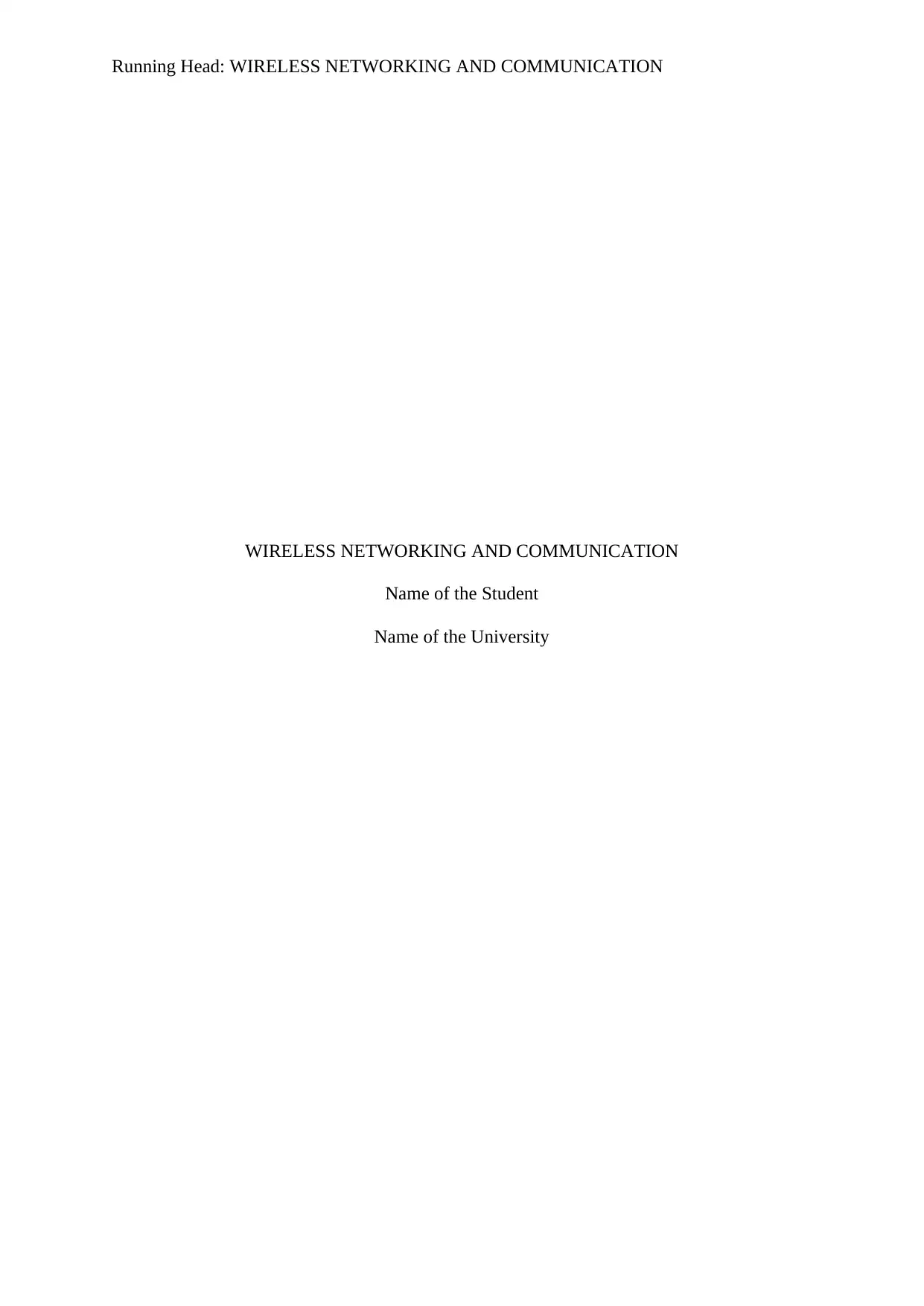
Running Head: WIRELESS NETWORKING AND COMMUNICATION
WIRELESS NETWORKING AND COMMUNICATION
Name of the Student
Name of the University
WIRELESS NETWORKING AND COMMUNICATION
Name of the Student
Name of the University
Paraphrase This Document
Need a fresh take? Get an instant paraphrase of this document with our AI Paraphraser
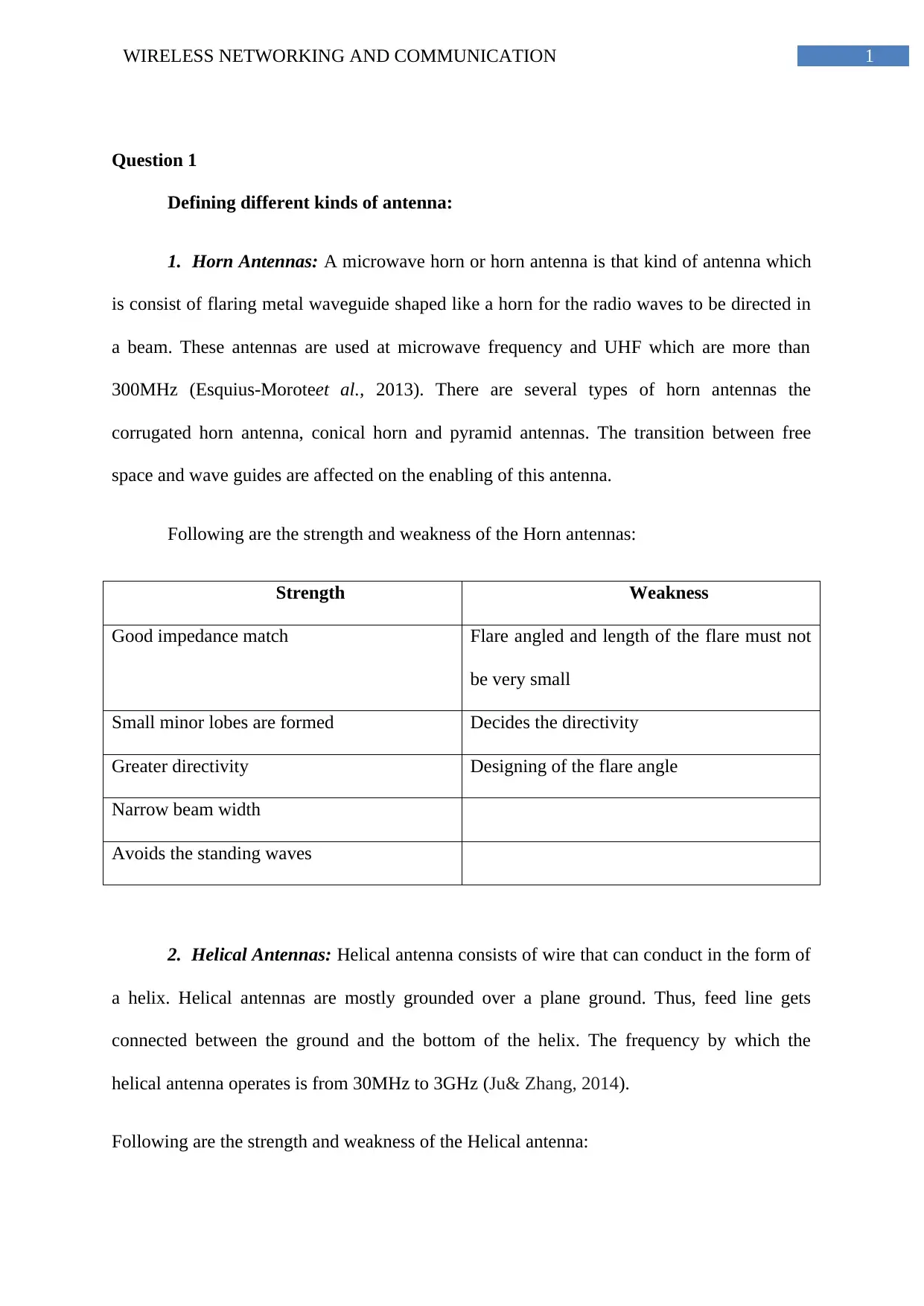
1WIRELESS NETWORKING AND COMMUNICATION
Question 1
Defining different kinds of antenna:
1. Horn Antennas: A microwave horn or horn antenna is that kind of antenna which
is consist of flaring metal waveguide shaped like a horn for the radio waves to be directed in
a beam. These antennas are used at microwave frequency and UHF which are more than
300MHz (Esquius-Moroteet al., 2013). There are several types of horn antennas the
corrugated horn antenna, conical horn and pyramid antennas. The transition between free
space and wave guides are affected on the enabling of this antenna.
Following are the strength and weakness of the Horn antennas:
Strength Weakness
Good impedance match Flare angled and length of the flare must not
be very small
Small minor lobes are formed Decides the directivity
Greater directivity Designing of the flare angle
Narrow beam width
Avoids the standing waves
2. Helical Antennas: Helical antenna consists of wire that can conduct in the form of
a helix. Helical antennas are mostly grounded over a plane ground. Thus, feed line gets
connected between the ground and the bottom of the helix. The frequency by which the
helical antenna operates is from 30MHz to 3GHz (Ju& Zhang, 2014).
Following are the strength and weakness of the Helical antenna:
Question 1
Defining different kinds of antenna:
1. Horn Antennas: A microwave horn or horn antenna is that kind of antenna which
is consist of flaring metal waveguide shaped like a horn for the radio waves to be directed in
a beam. These antennas are used at microwave frequency and UHF which are more than
300MHz (Esquius-Moroteet al., 2013). There are several types of horn antennas the
corrugated horn antenna, conical horn and pyramid antennas. The transition between free
space and wave guides are affected on the enabling of this antenna.
Following are the strength and weakness of the Horn antennas:
Strength Weakness
Good impedance match Flare angled and length of the flare must not
be very small
Small minor lobes are formed Decides the directivity
Greater directivity Designing of the flare angle
Narrow beam width
Avoids the standing waves
2. Helical Antennas: Helical antenna consists of wire that can conduct in the form of
a helix. Helical antennas are mostly grounded over a plane ground. Thus, feed line gets
connected between the ground and the bottom of the helix. The frequency by which the
helical antenna operates is from 30MHz to 3GHz (Ju& Zhang, 2014).
Following are the strength and weakness of the Helical antenna:
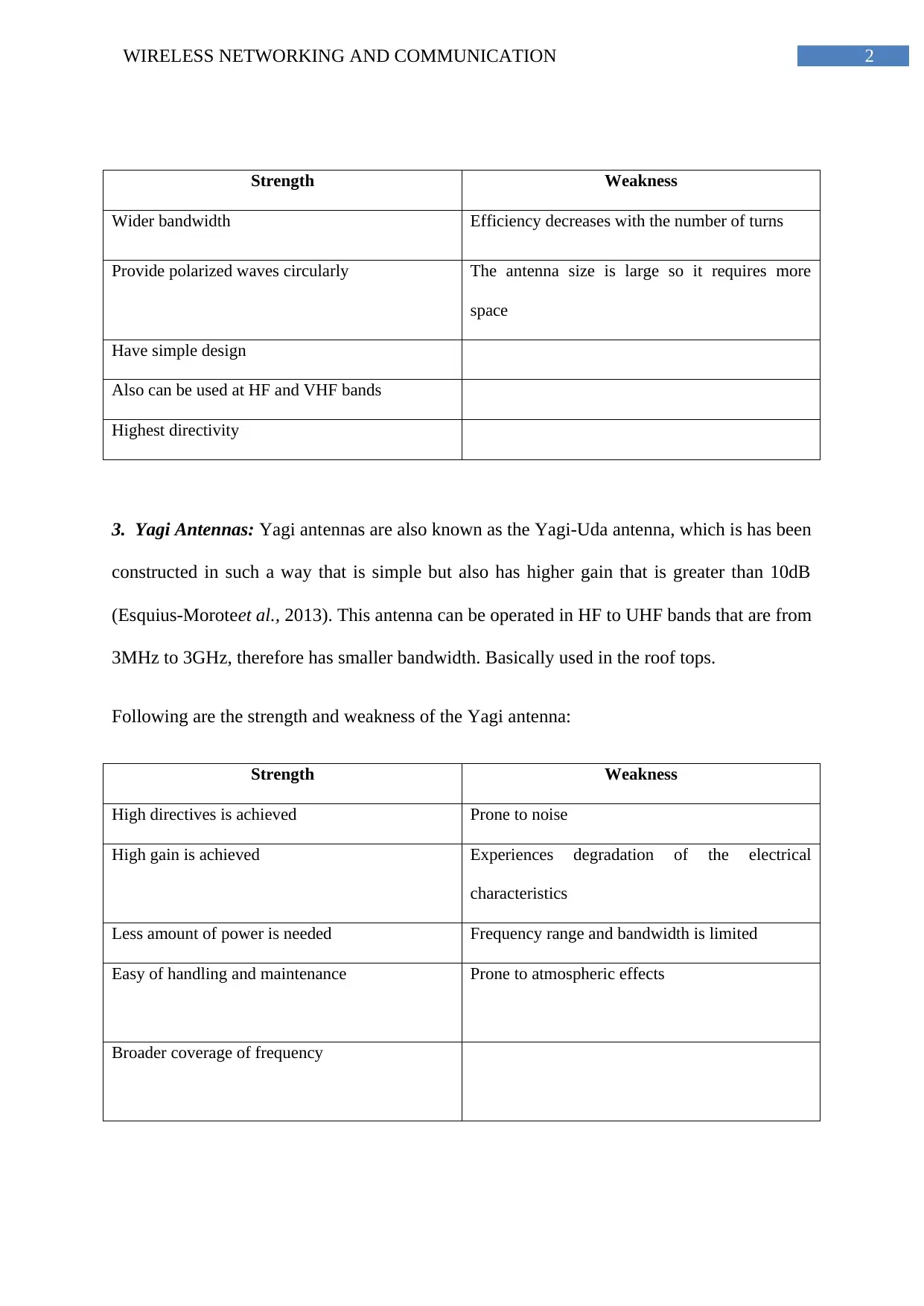
2WIRELESS NETWORKING AND COMMUNICATION
Strength Weakness
Wider bandwidth Efficiency decreases with the number of turns
Provide polarized waves circularly The antenna size is large so it requires more
space
Have simple design
Also can be used at HF and VHF bands
Highest directivity
3. Yagi Antennas: Yagi antennas are also known as the Yagi-Uda antenna, which is has been
constructed in such a way that is simple but also has higher gain that is greater than 10dB
(Esquius-Moroteet al., 2013). This antenna can be operated in HF to UHF bands that are from
3MHz to 3GHz, therefore has smaller bandwidth. Basically used in the roof tops.
Following are the strength and weakness of the Yagi antenna:
Strength Weakness
High directives is achieved Prone to noise
High gain is achieved Experiences degradation of the electrical
characteristics
Less amount of power is needed Frequency range and bandwidth is limited
Easy of handling and maintenance Prone to atmospheric effects
Broader coverage of frequency
Strength Weakness
Wider bandwidth Efficiency decreases with the number of turns
Provide polarized waves circularly The antenna size is large so it requires more
space
Have simple design
Also can be used at HF and VHF bands
Highest directivity
3. Yagi Antennas: Yagi antennas are also known as the Yagi-Uda antenna, which is has been
constructed in such a way that is simple but also has higher gain that is greater than 10dB
(Esquius-Moroteet al., 2013). This antenna can be operated in HF to UHF bands that are from
3MHz to 3GHz, therefore has smaller bandwidth. Basically used in the roof tops.
Following are the strength and weakness of the Yagi antenna:
Strength Weakness
High directives is achieved Prone to noise
High gain is achieved Experiences degradation of the electrical
characteristics
Less amount of power is needed Frequency range and bandwidth is limited
Easy of handling and maintenance Prone to atmospheric effects
Broader coverage of frequency
⊘ This is a preview!⊘
Do you want full access?
Subscribe today to unlock all pages.

Trusted by 1+ million students worldwide
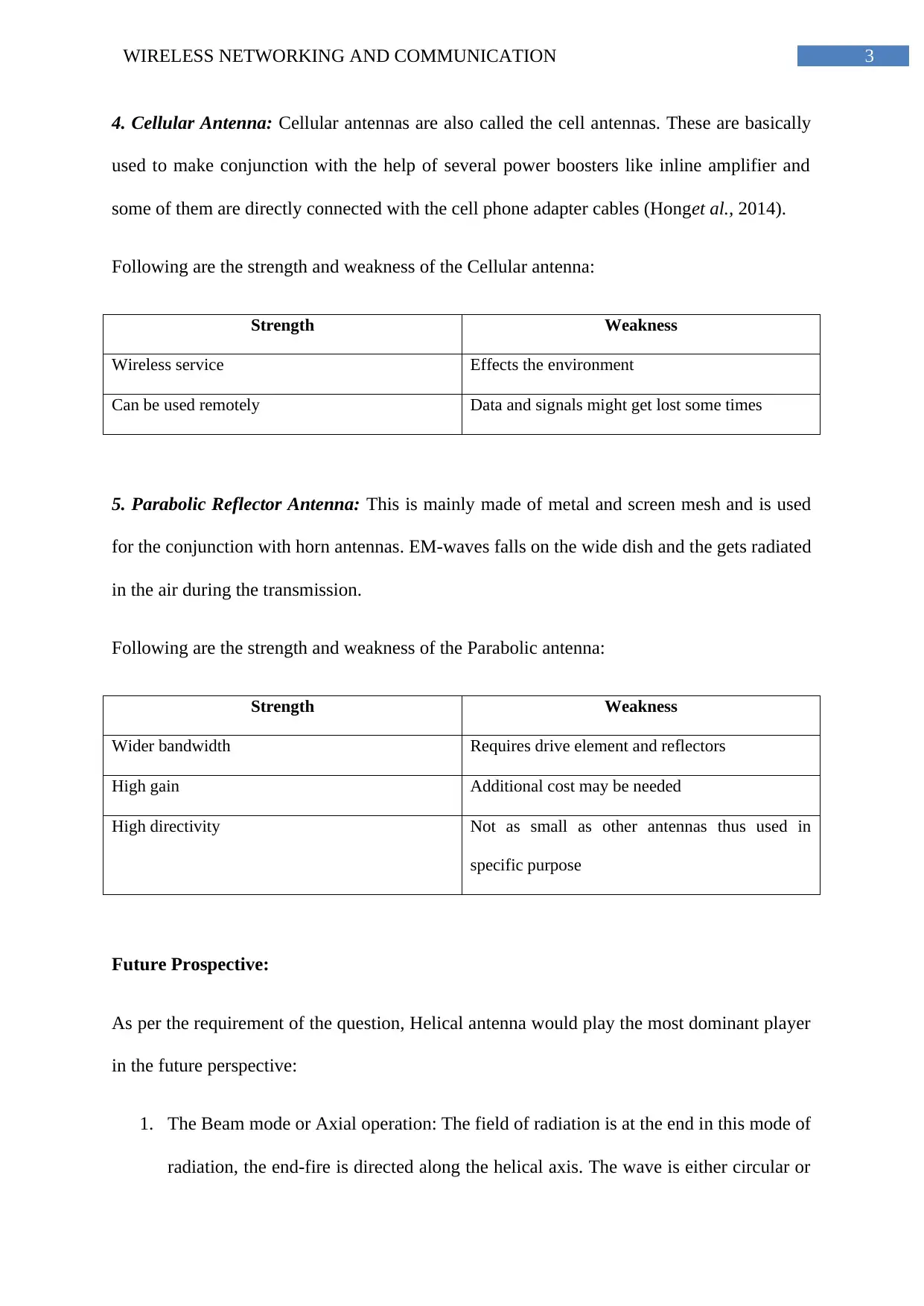
3WIRELESS NETWORKING AND COMMUNICATION
4. Cellular Antenna: Cellular antennas are also called the cell antennas. These are basically
used to make conjunction with the help of several power boosters like inline amplifier and
some of them are directly connected with the cell phone adapter cables (Honget al., 2014).
Following are the strength and weakness of the Cellular antenna:
Strength Weakness
Wireless service Effects the environment
Can be used remotely Data and signals might get lost some times
5. Parabolic Reflector Antenna: This is mainly made of metal and screen mesh and is used
for the conjunction with horn antennas. EM-waves falls on the wide dish and the gets radiated
in the air during the transmission.
Following are the strength and weakness of the Parabolic antenna:
Strength Weakness
Wider bandwidth Requires drive element and reflectors
High gain Additional cost may be needed
High directivity Not as small as other antennas thus used in
specific purpose
Future Prospective:
As per the requirement of the question, Helical antenna would play the most dominant player
in the future perspective:
1. The Beam mode or Axial operation: The field of radiation is at the end in this mode of
radiation, the end-fire is directed along the helical axis. The wave is either circular or
4. Cellular Antenna: Cellular antennas are also called the cell antennas. These are basically
used to make conjunction with the help of several power boosters like inline amplifier and
some of them are directly connected with the cell phone adapter cables (Honget al., 2014).
Following are the strength and weakness of the Cellular antenna:
Strength Weakness
Wireless service Effects the environment
Can be used remotely Data and signals might get lost some times
5. Parabolic Reflector Antenna: This is mainly made of metal and screen mesh and is used
for the conjunction with horn antennas. EM-waves falls on the wide dish and the gets radiated
in the air during the transmission.
Following are the strength and weakness of the Parabolic antenna:
Strength Weakness
Wider bandwidth Requires drive element and reflectors
High gain Additional cost may be needed
High directivity Not as small as other antennas thus used in
specific purpose
Future Prospective:
As per the requirement of the question, Helical antenna would play the most dominant player
in the future perspective:
1. The Beam mode or Axial operation: The field of radiation is at the end in this mode of
radiation, the end-fire is directed along the helical axis. The wave is either circular or
Paraphrase This Document
Need a fresh take? Get an instant paraphrase of this document with our AI Paraphraser
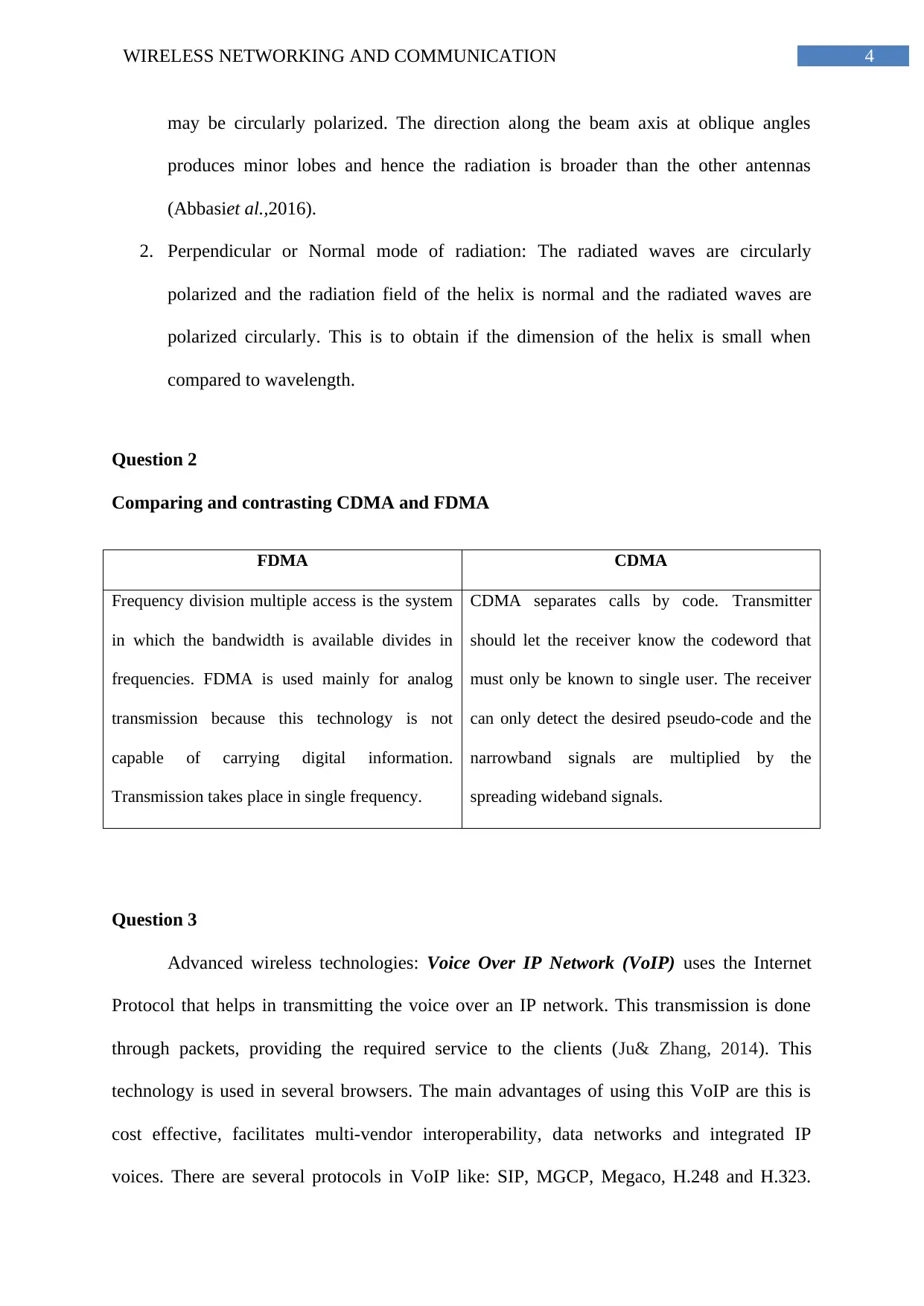
4WIRELESS NETWORKING AND COMMUNICATION
may be circularly polarized. The direction along the beam axis at oblique angles
produces minor lobes and hence the radiation is broader than the other antennas
(Abbasiet al.,2016).
2. Perpendicular or Normal mode of radiation: The radiated waves are circularly
polarized and the radiation field of the helix is normal and the radiated waves are
polarized circularly. This is to obtain if the dimension of the helix is small when
compared to wavelength.
Question 2
Comparing and contrasting CDMA and FDMA
FDMA CDMA
Frequency division multiple access is the system
in which the bandwidth is available divides in
frequencies. FDMA is used mainly for analog
transmission because this technology is not
capable of carrying digital information.
Transmission takes place in single frequency.
CDMA separates calls by code. Transmitter
should let the receiver know the codeword that
must only be known to single user. The receiver
can only detect the desired pseudo-code and the
narrowband signals are multiplied by the
spreading wideband signals.
Question 3
Advanced wireless technologies: Voice Over IP Network (VoIP) uses the Internet
Protocol that helps in transmitting the voice over an IP network. This transmission is done
through packets, providing the required service to the clients (Ju& Zhang, 2014). This
technology is used in several browsers. The main advantages of using this VoIP are this is
cost effective, facilitates multi-vendor interoperability, data networks and integrated IP
voices. There are several protocols in VoIP like: SIP, MGCP, Megaco, H.248 and H.323.
may be circularly polarized. The direction along the beam axis at oblique angles
produces minor lobes and hence the radiation is broader than the other antennas
(Abbasiet al.,2016).
2. Perpendicular or Normal mode of radiation: The radiated waves are circularly
polarized and the radiation field of the helix is normal and the radiated waves are
polarized circularly. This is to obtain if the dimension of the helix is small when
compared to wavelength.
Question 2
Comparing and contrasting CDMA and FDMA
FDMA CDMA
Frequency division multiple access is the system
in which the bandwidth is available divides in
frequencies. FDMA is used mainly for analog
transmission because this technology is not
capable of carrying digital information.
Transmission takes place in single frequency.
CDMA separates calls by code. Transmitter
should let the receiver know the codeword that
must only be known to single user. The receiver
can only detect the desired pseudo-code and the
narrowband signals are multiplied by the
spreading wideband signals.
Question 3
Advanced wireless technologies: Voice Over IP Network (VoIP) uses the Internet
Protocol that helps in transmitting the voice over an IP network. This transmission is done
through packets, providing the required service to the clients (Ju& Zhang, 2014). This
technology is used in several browsers. The main advantages of using this VoIP are this is
cost effective, facilitates multi-vendor interoperability, data networks and integrated IP
voices. There are several protocols in VoIP like: SIP, MGCP, Megaco, H.248 and H.323.
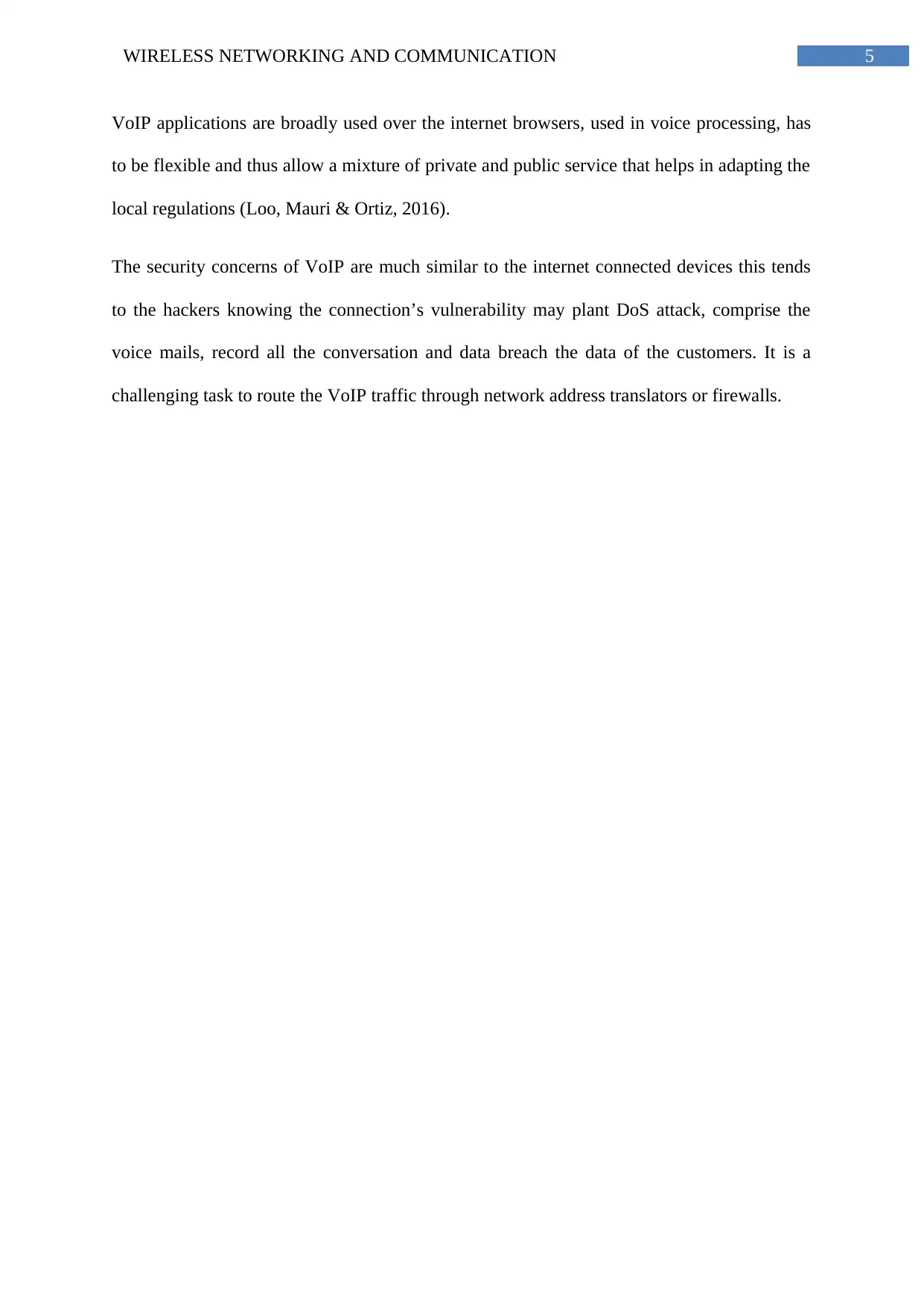
5WIRELESS NETWORKING AND COMMUNICATION
VoIP applications are broadly used over the internet browsers, used in voice processing, has
to be flexible and thus allow a mixture of private and public service that helps in adapting the
local regulations (Loo, Mauri & Ortiz, 2016).
The security concerns of VoIP are much similar to the internet connected devices this tends
to the hackers knowing the connection’s vulnerability may plant DoS attack, comprise the
voice mails, record all the conversation and data breach the data of the customers. It is a
challenging task to route the VoIP traffic through network address translators or firewalls.
VoIP applications are broadly used over the internet browsers, used in voice processing, has
to be flexible and thus allow a mixture of private and public service that helps in adapting the
local regulations (Loo, Mauri & Ortiz, 2016).
The security concerns of VoIP are much similar to the internet connected devices this tends
to the hackers knowing the connection’s vulnerability may plant DoS attack, comprise the
voice mails, record all the conversation and data breach the data of the customers. It is a
challenging task to route the VoIP traffic through network address translators or firewalls.
⊘ This is a preview!⊘
Do you want full access?
Subscribe today to unlock all pages.

Trusted by 1+ million students worldwide
1 out of 6
Related Documents
Your All-in-One AI-Powered Toolkit for Academic Success.
+13062052269
info@desklib.com
Available 24*7 on WhatsApp / Email
![[object Object]](/_next/static/media/star-bottom.7253800d.svg)
Unlock your academic potential
Copyright © 2020–2025 A2Z Services. All Rights Reserved. Developed and managed by ZUCOL.





